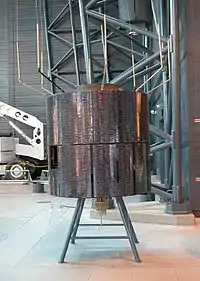ATS-4
ATS-4 (Applications Technology Satellite) was a communications satellite launched by NASA on August 10, 1968 from Cape Canaveral through an Atlas-Agena D rocket.
 The ATS-4. | |
| Mission type | Weather Satellite |
|---|---|
| Operator | NASA |
| COSPAR ID | 1968-068A |
| SATCAT no. | 03344 |
| Mission duration | 38 days |
| Spacecraft properties | |
| Bus | HS-306 |
| Manufacturer | Hughes Aircraft |
| Launch mass | 391 kilograms (862 lb) |
| Power | 130 W |
| Start of mission | |
| Launch date | August 10, 1968, 22:33:00 UTC |
| Rocket | Atlas-SLV3C Agena-D |
| Launch site | Cape Canaveral LC-36A |
| End of mission | |
| Disposal | August 10,1968 |
| Decay date | October 17, 1968 |
| Orbital parameters | |
| Reference system | Geocentric |
| Regime | LEO |
| Eccentricity | 0.03698 |
| Perigee altitude | 219 kilometres (136 mi) |
| Apogee altitude | 726 kilometres (451 mi) |
| Inclination | 29.4º |
| Period | 93.92 minutes |
Objectives
The objective of ATS-4 was to investigate the possibilities of a gravity gradient stabilization system (the method of stabilizing artificial satellites).
Features
The satellite has a cylindrical shape with a 142cm diameter and 183cm (about 360 cm considering the motor cover) with the surface covered by solar panels, and stabilized by gravity gradient.
Instruments
A total of four experiments were conducted during the mission:
- Microwave Transponder
- Gravity Gradient Stabilization
- Image Orthicon (Day/Night) Camera
- Ion Thruster
Mission
The ATS-4 launch vehicle failed in the ignition, resulting in an unplanned low elliptical orbit. The stress resulting from this orbit precipitated the fall of the spacecraft, yet, still achieved good results in some of the experiments. The primary objective to put a spacecraft stabilized by gravity gradient in orbit was not reached. The satellite reentered the atmosphere on 17 October 1968.